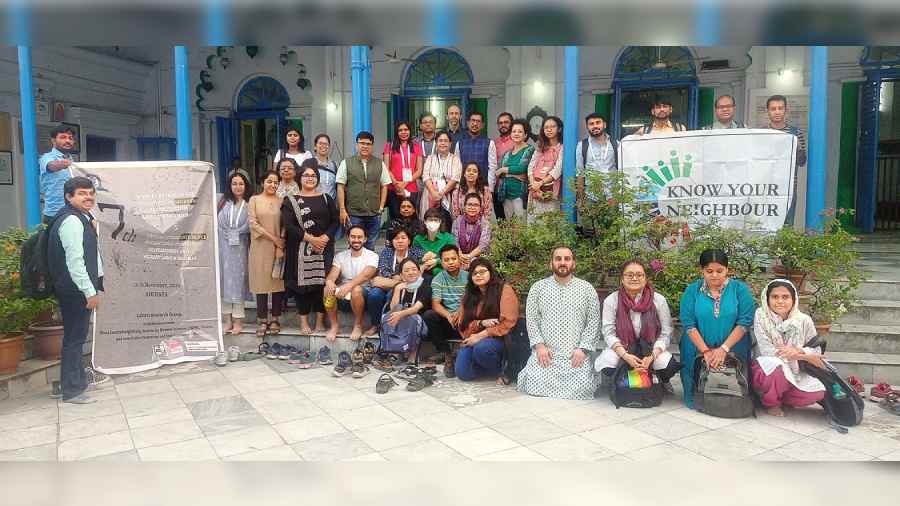Since the early days of colonial India, a pocket of the city has been the destination for migrant labourers from different parts of the country, who brought with them different social and cultural identities that helped make the melting pot that Kolkata is.
On Wednesday, some 50 people traversed through several nooks and corners of the pocket, stopping by some landmark spots — some of them associated with Nawab Wajid Ali Shah, exiled to Kolkata from Awadh by the British — and interacting with the local residents, some of them descendants of the early migrants.
The walk across the port areas of Kidderpore and Metiabruz was part of a workshop organised by the Calcutta Research Group, in collaboration with the Know Your Neighbour campaign.
Kidderpore and Metiabruz comprise Bengali-speaking Hindus and Muslims, Urdu and Hindi-speaking Muslims and Hindus primarily from the Purvanchal region (present eastern Uttar Pradesh, Bihar and Jharkhand) and Odisha and a small Anglo-Indian community, among others.
The participants were mostly researchers — teachers and PhD students — working on migration. Some of them came from other countries like England, Germany, Sri Lanka and Bangladesh.
“Kolkata is defined by stereotypes like rickshaws, trams, Victoria Memorial and Howrah Bridge. But there is a lot more to Kolkata, a fascinating history. These facets of history are fading away. But this is an integral part of our history and heritage,” said Samata Biswas, a member of Calcutta Research Group.

The researchers at Suriname Ghat.
Suriname Ghat, from where over a million Indians migrated as indentured workers to the Caribbean islands, South Africa, Mauritius and Fiji Islands to work in the sugar plantations during the colonial period, was one of the stops.
Many of the workers came from Bihar, Uttar Pradesh and the former Madras Presidency area. Each colony, whether it was Mauritius, Guyana or Suriname, had its depot in Calcutta where the indentured recruits were lodged while they waited for their sailing ship to arrive.
From these depots, they were taken to jetties or ghats to embark on smaller vessels that took them to the large ocean-ready ships. The jetties came to be known by the name of the destination to which the migrants were travelling.
Another stop, Bichali Ghat, is the place where Nawab Wajid Ali Shah’s steamer, McLeod, first docked in Kolkata on May 13, 1856. His palace, Sultankhana, is very close to the ghat.
A third, Sibtainabad lmambara, is a smaller and less ornate version of the Imambara in Lucknow and houses the graves of Wajid Ali Shah and his son Birjis Qadi.
Also in the area is St Stephen’s Church, popularly known as the Rocket Church because of its unique rocket-like steeple. The steeple was meant as a lantern for ships since the church is close to the port. The area was once thronged with seafaring people from all over the world.
It is believed that the church had been the place of worship for the governor-general.
Most of the older plaques are dedicated to seamen, who died at sea or even drowned in the Hooghly. The church fell into neglect after Independence. But today it stands well restored and the Sunday Mass is attended by a decent-sized gathering.
Kaveri, who is pursuing her PhD from the Tata Institute of Social Sciences in Mumbai, was one of the participants in the workshop.
“The walk helped me with a multi-layered understanding of migration — not just a struggle for livelihood but a pursuit of life in general. The history of a metropolitan city is essentially a history of migrants,” said Kaveri, who does not use a surname.
From sailing to uncharted terrains to struggling to choose between life and livelihood, the challenges faced by migrant workers have also evolved.
“We interacted with many truck drivers and labourers. We also interacted with social workers in those areas, people who provided food to thousands of stranded labourers and truck drivers on a daily basis during the lockdown,” said Biswas.
“Characteristic of dockyards and their surrounding neighbourhoods, Kidderpore has attracted migrant labourers from different parts of the country. Since the 1890s, the area has been a melting pot of different communities. It is imperative that we preserve this history,” said Sabir Ahamed of the Know YourNeighbour campaign that organises walks for people to get to know neighbourhoods in the city.
